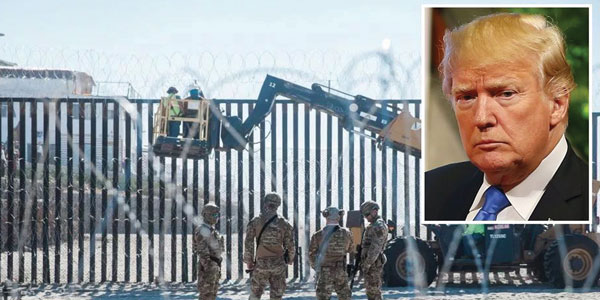
No matter how much you might want to seal the border between Mexico and the United States, it’s simply not possible. You might temporarily stop, delay, complicate or hinder the flow of immigrants and drugs from south to north, but nothing will ever stop it entirely. Though it may upset some politicians who’ve spent years making false promises, this is the reality of the situation.
If by some magic (or through behind-the-scenes negotiations), President Donald Trump could get the $5.7 billion he’s been asking for to build a wall, it would be of very little use. That money would only get him about 234 miles’ worth of wall, according to the White House. What about the rest of the border?
Those who buy into the myth that Trump’s wall would completely stem the illegal entry of drugs and people into the United States clearly have trouble with math. Here’s a crash course: The line dividing Mexico and the United States is 1,954 miles long. Right now, there are already walls and fences along about 700 miles. That still leaves 1,254 without any physical barrier. So even if Trump could build his new wall, there would still be an unfenced stretch of over 1,000 miles. End of lesson.
But Trump just won’t speak truth to his followers. And the truth is that a wall would be useless.
If there is anything immigrants are known for, it’s for their innovative thinking. When they come to a wall, they simply go around it. Or over it. Or they find a ladder to climb it. Or dig a tunnel underneath. Or they arrive by plane and overstay their visas. Walls by themselves are pretty useless.
Yet Trump keeps insisting on building his. He cites as an example the 440-mile wall that separates Israel from the Palestinian territories. First, it should be noted that this is not really a wall, but rather a military security system equipped with high-tech sensors and guarded by soldiers. And the Israelis and Palestinians are in a long-term conflict. The United States and Mexico are not. Since there are no plans to militarize the U.S. border, we’re effectively talking about two completely different things.
Second, there isn’t a crisis at the border warranting a wall or the deployment of troops. The number of undocumented immigrants arrested trying to cross it in 2017 was the lowest on record since 1971. According to government data, the number of undocumented immigrants in the United States has not increased in a decade, and they pose no threat to national security. Further, studies have concluded that immigrants commit fewer crimes than American-born citizens.
But when someone tries to demonstrate to Trump’s followers that there is no crisis at the border they get angry, and immediately point to the huge quantity of drugs entering the country. It is true that some 28 million Americans use drugs, making the United States the primary global market for narcotics. However, the majority of the heroin, cocaine and methamphetamine entering the country travels through customs checkpoints and legal ports of entry, according to recent reporting from The New York Times.
At some point we will have to accept the fact that the border between Mexico and the United States is nothing more than an invention. It was demarcated in 1848, following a war that cost Mexico about half its territory (it’s no coincidence that cities like Los Angeles, San Antonio and San Francisco have Spanish names). Also, it’s been said a thousand times that many people didn’t cross the border, the border crossed them. And the cultural and commercial ties between the two sides remain in place to this day — look at the fellowship exhibited by cities like El Paso, Texas, and Ciudad Juárez, Mexico — even if barbed wire and concrete barriers have been erected in some places along the divide.
Yes, all countries have the right to mark and protect their borders. But the histories and traditions of countries like Mexico and the United States are so intertwined that there is no practical or legal way a wall would keep them apart. Some politicians, like Trump, may well try to do come up with a way, but they are doomed to failure every time.
The border has been a crooked proposition from the beginning, and it will continue to be twisted to meet political ends.
P.S. For purposes of foreign policy, Mexico’s government is still recognizing the dictatorship of President Nicolás Maduro of Venezuela, who is responsible for mounting deaths, tightening censorship and the incarceration of political dissenters. However, one of the principles laid out in Article 89 (X) of the Mexican Constitution directs us “to respect, protect and promote human rights.” So, what comes next?
________________________________________________________
El Mito del Muro Perfecto
No es posible. Por más que quieran es, literalmente, imposible sellar la frontera entre México y Estados Unidos. Se puede detener temporalmente, retrasar, complicar u obstaculizar el paso de inmigrantes y de drogas del sur al norte. Pero nunca totalmente. Esa es la realidad. Aunque les duela a los políticos que prometen mentiras. Si por un acto de magia — o una de esas negociaciones en cuartos oscuros — el presidente Donald Trump consiguiera esos 5.700 millones de dólares para construir su muro, de muy poco serviría. Solo podría construir un nuevo muro en 234 millas. ¿Y qué haría con el resto de la frontera donde no hay muro? Los que se creen el mito de que el muro de Trump detendría casi totalmente la entrada ilegal de drogas y personas, no han hecho bien las sumas y las restas. Curso rápido de aritmética fronteriza: La línea que divide a México de Estados Unidos mide 1.954 millas. Actualmente ya hay muros y rejas en 700 millas. Es decir, quedan 1.254 millas sin ninguna barrera física. Incluso si Trump pudiera construir su nuevo muro, quedarían más de mil millas sin nada. Fin de curso. Trump no le quiere decir la verdad a sus seguidores. Y la verdad es que su muro no tendría ningún beneficio. Si algo tienen los inmigrantes es mucha imaginación. Así que cuando ven un muro, se van por un lado. O lo brincan. O trepan con una escalera. O cavan un túnel. O se vienen en avión con visa y luego se quedan. Los muros no sirven. Pero Trump dice que sí. Y cita, como ejemplo, las 440 millas de muro que separan a Israel de los territorios palestinos. Bueno, eso, más que un muro, es un sistema de seguridad militar con alta tecnología, sensores y soldados. Israel y los palestinos están en conflicto. Estados Unidos y México no; y no hay ningún plan actualmente para militarizar su frontera. O sea que estamos hablando de dos cosas totalmente diferentes. Además, no hay ninguna crisis en la frontera México-Estados Unidos que amerite más muro o más soldados. Los arrestos de inmigrantes tratando de cruzar ilegalmente hacia Estados Unidos en el 2017 fueron los más bajos desde 1971. El número de indocumentados dentro del país no ha subido en una década y no hay una amenaza a la seguridad nacional. Varios estudios concluyen que los inmigrantes cometen menos crímenes que los ciudadanos estadounidenses. Cuando le dices a la gente de Trump que no hay una crisis en la frontera, se enojan e inmediatamente te citan la enorme cantidad de drogas que entran a Estados Unidos. Es cierto. Estados Unidos — con más de 28 millones de personas usando drogas — es el principal mercado de narcóticos del mundo. Pero la gran mayoría de la heroína, cocaína y metanfetaminas que entra al país lo hace en vehículos por aduanas y puertos legales de entrada, como reportó recientemente The New York Times. En algún momento dado tendremos que reconocer que la frontera entre México y Estados Unidos es un invento. Fue demarcada en 1848 después de una desigual guerra en la que México perdió la mitad de su territorio. No es casualidad que ciudades como Los Ángeles, San Antonio y San Francisco lleven esos nombres. Se ha dicho mil veces que mucha gente no cruzó la frontera sino que la frontera los cruzó a ellos. Y esa relación fraternal y comercial entre los dos lados continúa hasta nuestros días, aunque les pongan púas, rejas y cemento de por medio. Basta ver, por ejemplo, la hermandad entre El Paso y Ciudad Juárez. Sí, todos los países tienen el derecho a marcar y proteger sus fronteras. Pero hay países, como México y Estados Unidos, cuyas historias, costumbres y tradiciones están tan entrelazadas que no hay manera, legal o práctica, de separarlos con un muro. Hay políticos que tratarán, como Trump. Aunque están condenados al fracaso. La frontera nació chueca y seguirá torcida.
Posdata: El gobierno de México, argumentando principios de política exterior, sigue reconociendo a la dictadura de Nicolás Maduro, responsable de asesinatos, censura y de tener prisioneros políticos. Sin embargo, el artículo 89, fracción X, de la Constitución mexicana dice, en parte, que uno de los principios es “el respeto, la protección y promoción de los derechos humanos”. ¿Entonces?










